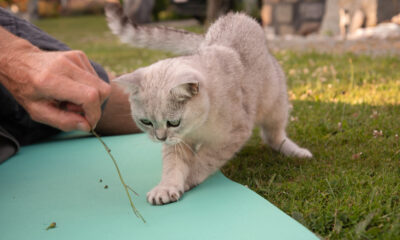Caring for a cat is an incredibly rewarding experience, but it comes with its own set of responsibilities. Whether you’re a seasoned cat owner or you’re bringing a furry companion into your life for the first time, it’s crucial to understand the key aspects of cat care to ensure your pet thrives. From nutrition and grooming to mental stimulation and health maintenance, here’s a complete guide on how to care for your cat.
Nutrition: The Cornerstone of a Healthy Cat
A well-balanced diet is the foundation for your cat’s overall well-being. Unlike dogs, cats are obligate carnivores, meaning they require animal protein to thrive. Here’s how to get their nutrition right:
Choose High-Protein Food: Always choose food that prioritizes real meat like chicken, turkey, or beef, and steer clear of products that use excessive fillers like corn or by-products. Cats need animal-based proteins to stay strong and energetic.
Wet vs. Dry Food Debate: While dry food can be more convenient, wet food is better at keeping your cat hydrated, especially since many cats don’t drink enough water. Consider feeding your cat a mix of both for variety and hydration benefits.
Portion Control: Obesity is a common problem among cats, so it’s essential to feed the right portion size.
Use the feeding guidelines on your cat food packaging, and be mindful of treats as they can add extra calories.
Regular Vet Visits: More Than Just Vaccinations
Visiting the vet is about more than just vaccinations. Regular health check-ups are essential for preventing health problems and keeping your cat in top condition.
Routine Checkups: Schedule an annual health exam for your cat to ensure they’re up-to-date on vaccinations and parasite prevention. This is also the time to get your cat checked for common issues like dental disease, obesity, or urinary tract problems.
Dental Care: Dental hygiene is often overlooked in cats. Cats can suffer from gum disease and tooth decay. Brushing your cat’s teeth regularly or providing dental treats can go a long way in preventing these issues.
Flea and Tick Prevention: Even indoor cats can be at risk of fleas and ticks, especially if they have access to outdoor areas or if you introduce fleas through clothing or other pets. Use preventive treatments as recommended by your vet.
Creating a Cat-Friendly Home: Space for Exploration and Rest
Cats are naturally curious and need both physical and mental stimulation to keep them happy. Here’s how you can set up an enriching environment for your feline friend:
Interactive Play: Cats are hunters by nature, and playtime mimics their natural hunting instincts. Invest in a variety of toys like feather wands, laser pointers, and puzzle feeders to keep them active and entertained.
Vertical Space: Cats love to climb and perch, so provide cat trees or shelves where your cat can enjoy high vantage points. This satisfies their need to observe their surroundings and can also reduce territorial behaviors.
Comfortable Resting Places: Cats sleep an average of 12–16 hours a day. Provide them with cozy beds, blankets, or even a window perch where they can curl up and nap in peace. A comfortable environment is key to their well-being.
Litter Box Etiquette: Keeping It Clean and Accessible
A clean litter box is one of the simplest ways to ensure your cat stays happy and healthy. Cats are very particular about their hygiene, and a dirty litter box can lead to behavioral issues.
Scoop Daily: To maintain a fresh environment, scoop the litter box at least once a day. Cats are less likely to use a dirty box, which could result in accidents outside the litter box.
Proper Number of Boxes: The general rule is one litter box per cat, plus one extra. So, if you have two cats, you should have at least three litter boxes in different locations around your home.
Choose the Right Litter: There’s no one-size-fits-all litter. Experiment with clumping, non-clumping, or natural options to see what your cat prefers. Keep the box in a quiet, low-traffic area to help your cat feel secure.
Grooming: Keeping Your Cat Clean and Comfortable
Even though cats are generally fastidious groomers, regular brushing and care can help prevent hairballs, matting, and skin issues. Here’s what you need to know:
Brushing: Regular brushing is essential, especially for long-haired breeds like Persians and Maine Coons. Brushing helps remove loose hair, reduces hairballs, and keeps their coat shiny and healthy.
Trimming Claws: Cats’ claws grow rapidly and can cause damage to furniture or even injure your cat if not properly maintained. Trim your cat’s claws every few weeks using cat-specific clippers.
Ear & Eye Care: Gently clean your cat’s ears and eyes if needed, especially if you notice discharge. Cats are prone to ear infections, so regular checks can help catch issues early.
Understanding Your Cat’s Behavior: The Key to a Happy Relationship
Cats are known for their independent nature, but they are also social creatures with complex behaviors. Understanding your cat’s body language and vocalizations will help you build a deeper bond:
Body Language: A cat’s tail, ears, and posture can tell you a lot about their mood. A puffed-up tail or flattened ears may indicate fear or aggression, while a slow blink is a sign of affection.
Respect Their Space: Cats appreciate their personal space. If they retreat to a quiet corner or under the bed, don’t force interaction. Let them come to you when they’re ready.
Purring and Kneading: When your cat purrs or kneads on you, it’s a sign of comfort and affection. This behavior is rooted in kittenhood, and it shows that your cat feels safe with you.
Health Issues to Watch For
Cats can be susceptible to a range of health issues. Being aware of the warning signs will help you seek treatment early and avoid complications:
Urinary Issues: Cats, especially males, are prone to urinary tract infections or blockages. Watch out for signs like frequent urination, straining, or blood in the urine. A sudden change in litter box habits is also a red flag.
Obesity: Obesity in cats can lead to a number of serious health issues like diabetes and joint problems. Monitor your cat’s weight, limit treats, and encourage playtime to keep them at a healthy weight.
Hairballs: Hairballs are common in long-haired breeds, but they can also occur in short-haired cats. Regular brushing can help reduce the frequency of hairballs.
Caring for Senior Cats
As your cat ages, they may require extra care. Senior cats may develop arthritis, lose their vision, or experience a decline in energy. Here’s how to provide the best care for your aging feline:
Comfortable Living Spaces: Senior cats may struggle to jump as high as they once did, so provide low, accessible resting places. Consider adding ramps or steps to furniture they like to visit.
Joint Support: If your cat shows signs of joint pain or stiffness, talk to your vet about joint supplements or medications that can help.
Regular Vet Visits: Older cats should have more frequent vet visits to monitor for age-related health issues. Annual exams might become bi-annual as they enter their senior years.
Conclusion: Happy Cats, Happy Homes
When it comes to cat care, there’s no “one-size-fits-all” solution. Every cat is unique, and understanding your pet’s individual needs is key to providing them with the best possible care. By focusing on nutrition, regular vet visits, grooming, and creating a stimulating environment, you’ll help ensure your cat leads a long, healthy, and fulfilling life.
So, whether you’re caring for a kitten or an aging cat, always remember that love, attention, and commitment are the cornerstones of a great relationship with your feline friend.

 Animal Facts8 years ago
Animal Facts8 years ago
 Pet Care Tips8 years ago
Pet Care Tips8 years ago
 Animal Facts8 years ago
Animal Facts8 years ago
 Animal Facts8 years ago
Animal Facts8 years ago
 Cats8 years ago
Cats8 years ago
 Animal Facts8 years ago
Animal Facts8 years ago
 Cats8 years ago
Cats8 years ago
 Animal Facts8 years ago
Animal Facts8 years ago



